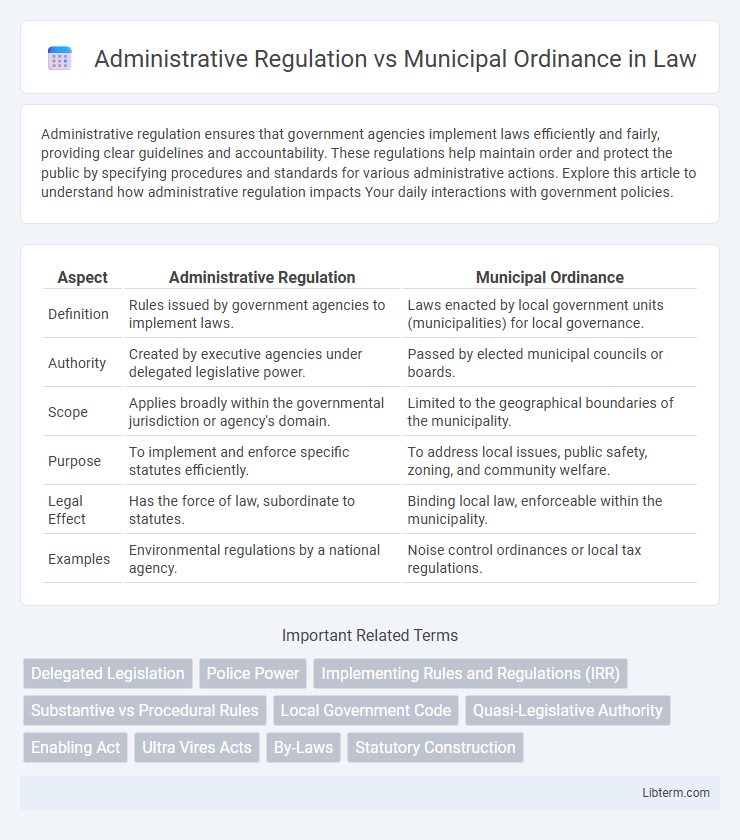Administrative regulation ensures that government agencies implement laws efficiently and fairly, providing clear guidelines and accountability. These regulations help maintain order and protect the public by specifying procedures and standards for various administrative actions. Explore this article to understand how administrative regulation impacts Your daily interactions with government policies.
Table of Comparison
| Aspect | Administrative Regulation | Municipal Ordinance |
|---|---|---|
| Definition | Rules issued by government agencies to implement laws. | Laws enacted by local government units (municipalities) for local governance. |
| Authority | Created by executive agencies under delegated legislative power. | Passed by elected municipal councils or boards. |
| Scope | Applies broadly within the governmental jurisdiction or agency's domain. | Limited to the geographical boundaries of the municipality. |
| Purpose | To implement and enforce specific statutes efficiently. | To address local issues, public safety, zoning, and community welfare. |
| Legal Effect | Has the force of law, subordinate to statutes. | Binding local law, enforceable within the municipality. |
| Examples | Environmental regulations by a national agency. | Noise control ordinances or local tax regulations. |
Understanding Administrative Regulations
Administrative regulations are rules issued by government agencies that implement and enforce statutes, providing detailed guidelines for compliance and procedural conduct. These regulations often have the force of law within their specific administrative domain and are designed to ensure efficient and consistent application of legislative intent. Understanding administrative regulations involves recognizing their role in shaping policy execution, regulatory oversight, and administrative decision-making processes.
Defining Municipal Ordinances
Municipal ordinances are legally binding local laws enacted by a city or municipal government to regulate issues within its jurisdiction, such as zoning, public safety, and health standards. These ordinances carry the authority of local governance and must align with state and federal laws while addressing specific community needs. Unlike administrative regulations, which are rules created by government agencies to implement statutes, municipal ordinances are legislated by elected local officials and have the force of law within the municipality.
Key Differences Between Administrative Regulations and Municipal Ordinances
Administrative regulations are rules issued by government agencies to implement and enforce laws, focusing on specific operational procedures within executive branches. Municipal ordinances are local laws enacted by city or town councils to govern community behavior, zoning, and public safety within their jurisdiction. While regulations have a narrower scope tied to agency authority, ordinances possess broader legislative power directly affecting residents and local governance.
Legal Basis and Authority
Administrative regulations derive their authority from statutes enacted by legislative bodies, granting agencies the power to create detailed rules within the scope of enabling legislation. Municipal ordinances are local laws enacted by city or town councils, grounded in state constitutional provisions or statutes that delegate lawmaking power to municipal governments. The legal basis of administrative regulations lies primarily in administrative law, whereas municipal ordinances are rooted in local government law and charter provisions.
Scope and Coverage
Administrative regulations govern the operations and procedures of government agencies, focusing on implementing and enforcing laws within specific administrative domains. Municipal ordinances are local laws enacted by city or county governments that address community-specific issues such as zoning, public safety, and local business regulations. The scope of administrative regulations is limited to agency functions, while municipal ordinances cover broader local governance and community standards.
Enactment and Implementation Processes
Administrative regulations are enacted through a rule-making process led by government agencies, involving public notice and comment periods before implementation, ensuring alignment with statutory authority. Municipal ordinances are passed by local governing bodies such as city councils, requiring formal votes and adherence to local legislative procedures before taking effect. Enforcement of administrative regulations typically involves agency oversight, while municipal ordinances are enforced through local government mechanisms including law enforcement and municipal courts.
Enforcement Mechanisms
Administrative regulations are enforced through designated government agencies empowered to issue fines, impose sanctions, or suspend licenses for non-compliance. Municipal ordinances rely on local law enforcement and municipal courts to ensure compliance, often involving penalties such as fines, community service, or other legal actions. Both enforcement mechanisms are designed to uphold regulatory compliance, yet vary by jurisdiction and scope of authority granted by enabling statutes.
Impact on Local Governance
Administrative regulations establish procedures and standards that government agencies must follow, directly influencing the efficiency and consistency of public service delivery. Municipal ordinances, enacted by local governments, address community-specific issues such as zoning, public safety, and local taxes, enhancing responsiveness to residents' needs. The interaction between administrative regulations and municipal ordinances shapes the framework for local governance, balancing regulatory compliance with tailored community solutions.
Advantages and Limitations
Administrative regulations allow government agencies to implement detailed rules within the scope of existing laws, providing flexibility and specialized expertise in enforcement. Municipal ordinances offer local governments direct legislative authority to address community-specific issues, promoting tailored solutions reflecting the residents' needs. However, administrative regulations may face challenges in transparency and public participation, while municipal ordinances can be limited by preemption from higher government laws and may vary widely in effectiveness across jurisdictions.
Choosing the Appropriate Legal Instrument
Selecting the appropriate legal instrument hinges on the scope and authority granted to the issuing body. Administrative regulations are issued by government agencies to implement specific statutes and have detailed, technical provisions, while municipal ordinances are local laws enacted by city or town governments addressing community-specific issues. The choice depends on whether the rule serves regulatory functions within an agency's jurisdiction or addresses local governance and public welfare concerns.
Administrative Regulation Infographic

 libterm.com
libterm.com